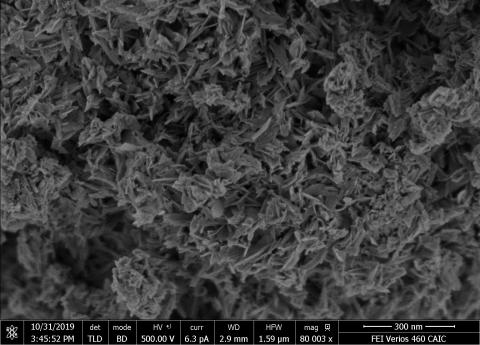Imaging uncoated samples
Octa-calcium phosphate imaged uncoated in UC/BD mode using a 2000 V stage bias (OCP-L-50%, Rui Li, Duer Group, Yusuf Hamied Dept. Of Chemistry, Cambridge).
When performing high-resolution imaging, e.g. of nanoparticles or thin-films, sputter-coating with metals or carbon becomes increasingly undesirable as the coating itself will start to conceal the fine detail of the sample surface. Imaging uncoated samples, however, can present difficulties: many samples will be non-conductive and suffer increased charging effects; charging can be ameliorated by using lower accelerating voltages and probe currents, but this in turn lowers the signal-to-noise ratio; also, the quality of the primary electron beam decreases with lower beam energies.
These problems can be overcome by using the Verios 460 UniColor (UC) and beam deceleration (BD) modes. In UC mode, the beam electrons pass through a narrow slit (monochromator) producing a primary electron beam with a smaller energy spread, minimizing chromatic aberration. The BD mode applies a negative voltage bias to the specimen stage, which decelerates the primary beam electrons before they hit the sample. This means a higher accelerating voltage can be applied - resulting in a higher quality primary electron beam - but the landing energy of the beam electrons on the sample is lower, resulting in a smaller interaction volume and minimizing charging and beam damage. At the same time, the negative stage bias `pushes’ the signal electrons coming from the sample up towards the detectors improving the signal-to-noise ratio.
For BD imaging to work well, samples need to be relatively flat. On rough surfaces, increased astigmatism and image distortions can become a problem. On the Verios 460, the lowest accelerating voltage possible is 350 eV, minimum probe current is 0.8 pA and the stage bias can be adjusted between 50 - 4000 V. The Verios cryo-stage is also BD-enabled.

